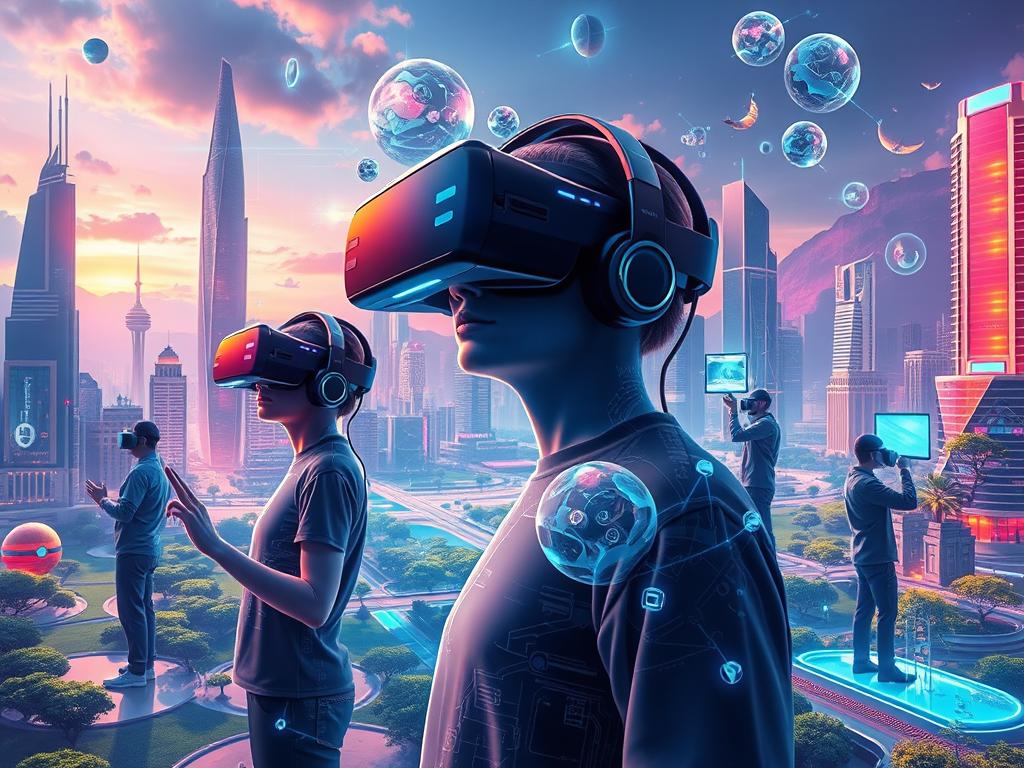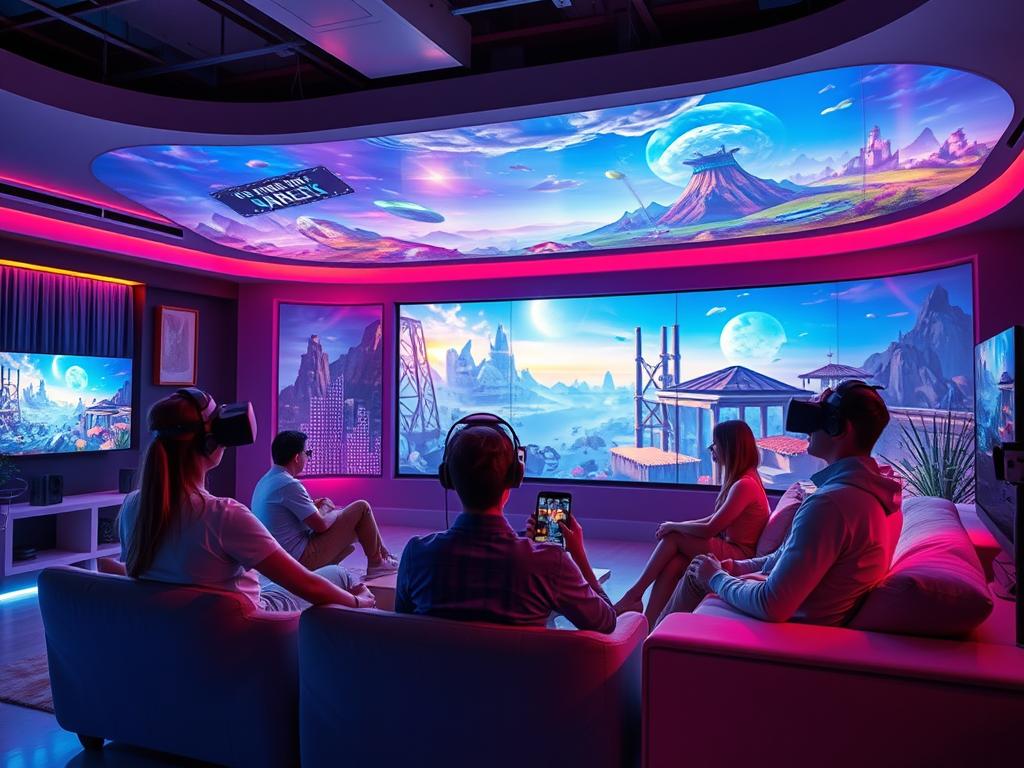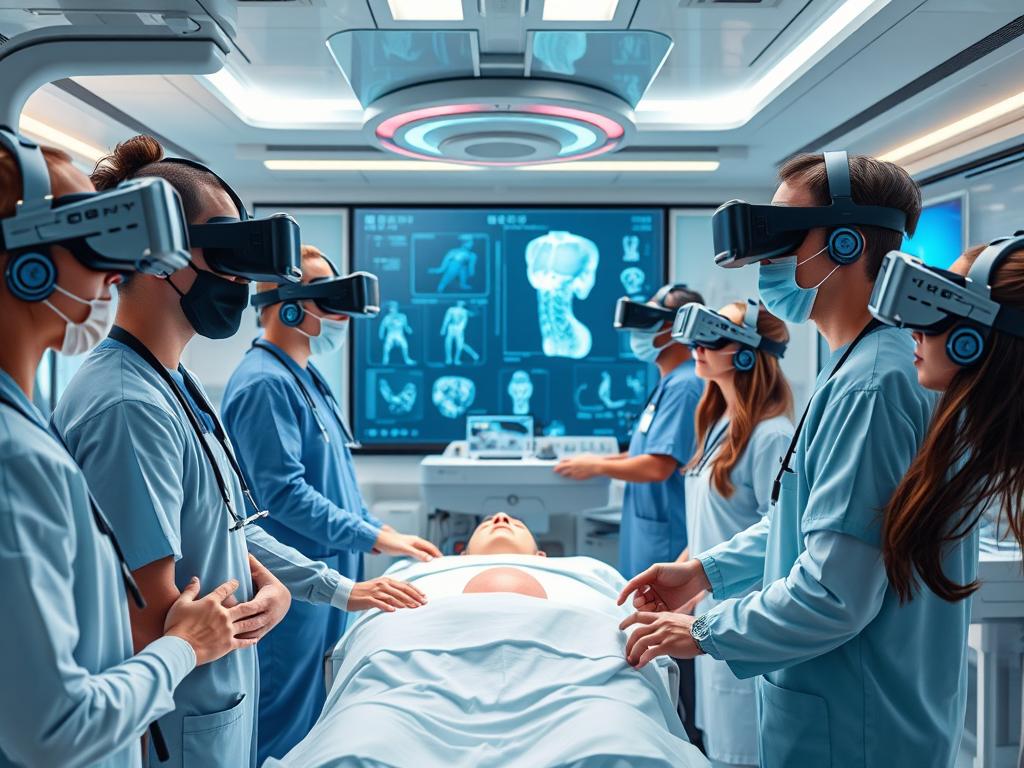Did you know that the value of the market for virtual reality (VR) business equipment is projected to skyrocket from $829 million in 2018 to a staggering $4.26 billion by 2023? This remarkable growth signifies the increasing interest and adoption of virtual reality technology.
The future of virtual reality is not just a tech trend; it’s a revolutionary shift that promises to transform various aspects of our daily existence. From immersive gaming experiences to innovative applications in education and healthcare, VR is set to dramatically reshape how we engage with the digital and physical worlds.
With industry giants like Facebook acquiring Oculus, which sparked a renewed interest in VR after its initial prototype launch in 2012, we can see how quickly this technology is gaining traction.
Experts indicate that this rapid progress is fueled by advancements in VR technology that enhance user experiences and accessibility. As immersive and non-immersive simulations find their place in diverse industries, such as exercise and training, the potential for virtual reality to improve our lives is vast. To explore how VR is evolving and what it means for our future, please read more about it here.
Key Takeaways
- VR technology is categorized into immersive and non-immersive experiences.
- The market for VR equipment is expected to significantly increase in the next few years.
- Applications of VR span across various sectors, including education, healthcare, and entertainment.
- Technological advancements are making VR more accessible and practical for users.
- Major companies are heavily investing in VR developments, indicating its growing importance.
Understanding Virtual Reality: An Overview
Virtual reality (VR) offers a unique and captivating way to experience simulated environments. It immerses users in a completely virtual world, creating an engagement level that traditional media seldom matches. With the evolution of this technology, various virtual reality applications have emerged across multiple industries, providing significant benefits of virtual reality that extend beyond mere entertainment.
What is Virtual Reality?
At its core, virtual reality refers to computer-generated simulations that allow users to interact within a three-dimensional space. By employing specialized headsets and controllers, individuals can explore these immersive experiences as if they were genuinely present within them. The growth of VR has launched companies into fresh territories, enabling applications in sectors like education, healthcare, and gaming.
Key Technologies Driving VR Development
Several crucial technologies contribute to the rapid advancement of virtual reality, including:
- Advanced headsets, such as the Meta Quest 3 and Apple’s Vision Pro, providing high-resolution displays and enhancing user experiences.
- Motion sensing technology that tracks user movements, fostering a natural interaction with virtual environments.
- Augmented reality that adds layers of information to the real world, enriching the VR experience.
The influx of these technologies is leading to high adoption rates across various sectors, as demonstrated by agencies employing immersive technologies. This growth indicates an exciting future for VR applications.
The Evolution of Virtual Reality
The journey of virtual reality traces back to early concepts in the 1980s, gradually transforming into the sophisticated systems we see today. Global unit sales of VR headsets reached approximately 6.1 million in 2021, with a cumulative installed base of over 16.44 million. Despite fluctuating excitement about the metaverse, the overall public interest remains strong, as over a quarter of consumers express enthusiasm for what VR technologies can offer.
From its inception to the present, VR has showcased its potential across diverse fields. Companies increasingly leverage virtual reality for purposes such as prototyping, design, and staff training, emphasizing the growing significance of immersive experiences in the business world. Insights into these developments reflect a promising trajectory as innovative devices and applications continue to reshape our engagement with technology.

As we delve deeper into the potential of virtual reality and its myriad applications, it’s essential to recognize the transformative nature of these technologies, including their profound impact on education and healthcare. More insights on how VR reshapes these fields can be explored here.
The Impact of VR on Entertainment
The integration of virtual reality technology into the entertainment landscape is transforming how audiences interact with various media formats. The VR impact on society is becoming increasingly noticeable as this innovative medium offers unique experiences that blend entertainment with immersive storytelling.
Immersive Gaming Experiences
The gaming industry stands at the forefront of the virtual reality entertainment industry, with intensive experiences that allow players to feel truly engaged in their adventures. Projections indicate the VR gaming segment will generate an impressive 5 billion USD out of the total 5.92 billion USD in the VR software Business-to-Consumer market by 2028. This stunning growth reflects the growing demand for immersive gameplay that transcends traditional gaming formats.
Revolutionizing Film and Television
VR is reshaping storytelling in film and television, allowing viewers to interact directly with narrative content. Through VR experiences, audiences find themselves inside story worlds, making choices and influencing outcomes. The movie and entertainment market, projected to grow at a CAGR of 8.1% from 2024 to 2030, highlights the rising interest in 3D films and immersive experiences, underscoring the VR impact on society.
Expanding Theme Park Attractions
Theme parks are capitalizing on virtual reality experiences to attract visitors and enhance attractions. By incorporating VR technology into rides and experiences, parks can offer new levels of excitement and engagement. This trend caters to a wider audience looking for unique adventures, driving growth in the entertainment sector. The innovations emerging from the virtual reality entertainment industry truly reflect the evolving landscape of leisure activities.

| Category | Projected Revenue (USD) | CAGR (2024-2029) |
|---|---|---|
| VR Software Market | 4.3 billion | 7.46% |
| VR Gaming Segment | 5 billion | – |
| VR Hardware Market | 11.4 billion | 9.35% |
| Global VR Gaming Market | 189.17 billion | 30.4% |
| Entertainment & Movies Market | – | 8.1% |
As we witness these developments, the fusion of virtual reality technology with entertainment continues to signal a shift in how we engage with various forms of media. For deeper insights on the ongoing changes in this sector, explore the evolution within the virtual reality entertainment industry for a broader perspective on future trends.
VR in Education: A New Learning Paradigm
Virtual reality in education offers a transformative approach to learning, engaging students in ways that traditional methods cannot. Research indicates that VR experiences significantly increase information retention. This advancement opens pathways for interactive lessons that captivate students, promising a more effective educational journey.
Enhancing Classroom Experiences
Incorporating virtual reality into classroom settings enriches the learning environment. Students can partake in immersive lessons, benefiting from a multi-sensory experience that fosters deeper understanding. Educators can utilize virtual environments to demonstrate complex concepts in real-time. Faculty can also assess student performance by creating real or simulated scenarios, encouraging practical engagement.
Virtual Field Trips and Simulations
With virtual reality in education, students can embark on virtual field trips to distant locations without leaving their classrooms. This method not only makes learning more dynamic but also fosters experiential learning. Virtual laboratories enhance collaborative learning, allowing students to perform scientific experiments safely. Innovations such as haptic feedback improve interactions, making these simulated experiences even more lifelike.
Skill Development and Training
VR technology is essential for skill training, particularly in fields like healthcare and technical education. Immersive experiences can decrease training time significantly while improving performance. A marked improvement in employee performance—a reported 130% increase—demonstrates VR’s practical benefits in training scenarios. Online virtual worlds foster community building among students and facilitate real-time interaction with faculty around the globe.
The challenges of integrating virtual reality in education include high costs and the need for a robust technical infrastructure. Additionally, both teachers and students face a learning curve in utilizing VR technology effectively.
Investment in training and infrastructure remains crucial for harnessing the full potential of virtual reality in educational curricula. Despite these hurdles, the future of learning is undeniably bright with the integration of VR technology.
For an engaging online experience, exploring cooperative gameplay in virtual worlds can enhance social connections among students through online gaming communities.
Transforming Workplaces with Virtual Reality
As companies continue to adapt to new ways of working, virtual reality technology emerges as a vital tool for enhancing productivity and collaboration. The integration of VR in workplaces proves to be transformative, fostering teamwork and innovative approaches across various sectors.
Remote Collaboration and Meetings
Virtual reality technology enhances remote collaboration by creating immersive environments where teams feel as if they inhabit the same space. This sense of presence significantly improves communication and engagement during meetings. Organizations increasingly adopt mixed-reality rooms and provide VR headsets to facilitate seamless interactions, allowing employees in different locations to contribute effectively.
Virtual Reality in Training and Development
Training programs benefit immensely from the application of VR, particularly in high-risk scenarios. Notable entities, such as NASA and Walmart, leverage virtual reality to create realistic training simulations that reduce the risk of injuries. This approach accelerates the learning process, leading to a shorter time to competence for new hires. The standardization of workflows through VR not only optimizes learning outcomes but also fosters higher retention rates among employees.
Improving Accessibility in Work Environments
Virtual reality technology opens doors for individuals with disabilities, encouraging inclusivity within workplaces. By providing customized training and collaborative tools, VR promotes an accessible environment that allows all employees to thrive. Companies adopting VR for training and development play a pivotal role in shaping diverse teams and paving the way for a more equitable future.

| Feature | Traditional Methods | VR Implementation |
|---|---|---|
| Collaboration | Limited interaction in remote meetings | Immersive environments enhance engagement |
| Training | Physical simulations with risks | Zero-risk scenarios for high-risk training |
| Accessibility | Barriers for individuals with disabilities | Customizable tools promote inclusivity |
| Cost Efficiency | High expenses for physical prototypes | Reduced costs with virtual prototyping |
The Future of Healthcare through Virtual Reality
The integration of virtual reality (VR) in healthcare is setting the stage for revolutionary advancements in patient treatment, medical training, and overall patient care. As the VR market in healthcare is projected to expand from $628 million in 2022 to $6.2 billion by 2029, its acceptance and role in the industry are becoming increasingly evident. The benefits of virtual reality are transforming traditional approaches, offering innovative solutions for both practitioners and patients.
VR in Patient Treatment and Therapy
VR in healthcare has opened new avenues for treating various psychological and physical conditions. Therapies utilizing VR have shown significant effectiveness, such as reducing pain and anxiety in burn patients by 24%, based on research from the University of Washington. Furthermore, studies indicate a remarkable 68% reduction in fear among phobic patients utilizing VR therapy, demonstrating the potential for managing psychological conditions effectively.
Programs like the IREX® VR system and the Bertec Balance Advantage™ System enhance strength and endurance in rehabilitation, showcasing the comprehensive benefits of virtual reality.
Medical Training and Simulation
Medical training has greatly benefitted from VR technologies. A notable statistic from the Harvard Business Review shows that VR training enhances surgical skills by up to 230% compared to traditional methods. Medical students utilizing immersive VR report substantial improvements in knowledge retention and skill acquisition.
Interactive simulations allow students to engage in life-like scenarios, significantly increasing confidence and competence before entering real-world medical environments. Such immersive experiences are crucial for effective patient-centered care.
Enhancing Patient Care and Communication
Enhanced communication between healthcare providers and patients is another key advantage of VR tools. Telehealth services now incorporate VR, facilitating remote monitoring and therapy without requiring in-person visits. This shift not only increases patient engagement but also improves overall satisfaction with care. Numerous studies highlight the role of VR applications in enhancing treatment plans, ultimately leading to better patient outcomes and quality of care.
| Application | Effectiveness | Source |
|---|---|---|
| VR Therapy for Pain and Anxiety | 24% reduction in pain and anxiety for burn patients | University of Washington |
| Reduction of Fear | 68% reduction in fear among phobic patients | Phobia Treatment Study |
| Surgical Skills Improvement | 230% increase in surgical skills using VR training | Harvard Business Review |
| Enhanced Medical Training | Significant improvement in knowledge retention | Various Studies |
| Telehealth Efficiency | Improves remote monitoring and engaging therapy | Chunara et al. (2021) |
As VR continues to evolve, its role in healthcare will only expand. Embracing the benefits of virtual reality is essential for practitioners looking to improve patient care and training processes effectively. For further insights on the impact of VR and brain-computer interfaces in healthcare, you can explore this link here.
Challenges Ahead: The Road to Widespread Adoption
The journey towards the widespread adoption of virtual reality applications is paved with challenges that need to be addressed. One of the most significant hurdles lies in technical limitations. Users often encounter issues such as hardware performance inconsistencies and software compatibility, which can drastically affect the overall user experience. As VR technologies continue to evolve, ensuring seamless functionality across various devices will be crucial to enhancing the VR impact on society.
Addressing Technical Limitations
Another pressing concern is managing privacy and security issues associated with virtual reality environments. The data collected during VR usage—including face and object recognition, location tracking, and user movement—raises substantial privacy concerns, especially amongst younger users.
With companies like Facebook and Snap planning new wearable technologies, there is an urgent need to establish strict control measures that protect user data while still offering innovative experiences. By doing so, stakeholders can create an environment of trust that encourages broader acceptance of VR solutions.
Managing Privacy and Security Concerns
Lastly, societal acceptance of virtual reality presents a significant barrier. Despite the potential benefits, skeptics often question the value, safety, and practicality of virtual experiences. To overcome these acceptance issues, it is essential to educate the public about the varied applications of VR—from enhancing educational experiences to providing therapeutic benefits in healthcare.
As the number of active VR users continues to rise, projected to reach 171 million by 2024, promoting the positive aspects of VR and its applications will be vital in changing public perception. Addressing these challenges effectively will foster a more favorable environment for the adoption and growth of VR technology. To stay informed on these innovations, you can explore more about the advancements in the field of virtual reality at this resource.











